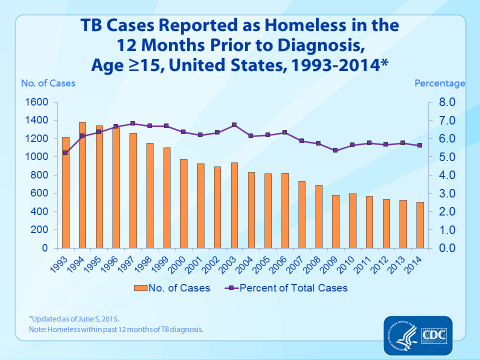TB in the Homeless Population
Background
A disproportionate number of TB cases occur among high-risk populations, including people experiencing homelessness.
In the United States, 1% of the population experiences homelessness in a given year, but more than 5% of people with TB reported being homeless within the year prior to diagnosis. These findings are not surprising, as people experiencing homelessness have a high occurrence of conditions that increase the risk of TB, including substance abuse, HIV infection, and congregation in crowded shelters. This combination of conditions is favorable for spreading TB. In addition, people who are homeless often lack ready access to the medical care required to make an early diagnosis of TB.

What CDC is Doing
To address TB among the homeless population, CDC is
- Collaborating with other national and public health organizations to improve screening, diagnosis, and treatment for people experiencing homelessness.
- Working to improve TB control activities in partnership with healthcare agencies addressing the needs of people experiencing homelessness.
In the fall of 2015, CDC hosted a “Workshop on Tuberculosis (TB) and Homelessness: Infection-Control Measures in Homeless Shelters and Other Overnight Facilities that Provide Shelter.” The workshop brought together homeless service providers, TB controllers, and public health department staff to engage in strategic planning around improving TB control among persons experiencing homelessness and prevent new TB incidence among those utilizing and providing services (i.e., clients, staff and volunteers).
The homeless population represents an important risk group among U.S.-born TB patients. To achieve TB elimination, ongoing efforts are needed to address the disproportionate number of TB cases among this high-risk population.
CDC Resources on the Homeless Population
- Prevention and Control of Tuberculosis in Correctional and Detention Facilities; Recommendations from CDC MMWR 2006; 55 (No, RR-09, 1-44)
- Reported Tuberculosis in the United States, 2014
- Notes from the Field: Tuberculosis Cluster Associated with Homelessness — Duval County, Florida, 2004–2012 MMWR 2012; 61 (No. 28)
- Tuberculosis Outbreak Associated with a Homeless Shelter – Kane County, Illinois, 2007–2011 MMWR 2012; 61 (No. 11, 186-189)
- Tuberculosis Transmission in a Homeless Shelter Population - New York, 2000-2003
MMWR 2005; 54 (No. 06)
Additional Resources
TB Facts Series
Questions and Answers about Tuberculosis
For additional CDC resources on TB, see Patient and General Public Materials.
For Health Care Providers
- Page last reviewed: January 23, 2013
- Page last updated: January 23, 2013
- Content source:


 ShareCompartir
ShareCompartir